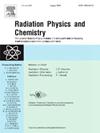Physico-mechanical properties of bio-plasticized PVC crosslinked by electron beam irradiation
IF 2.8
3区 物理与天体物理
Q3 CHEMISTRY, PHYSICAL
引用次数: 0
Abstract
In the last decades, bio-plasticizers such as epoxidized soybean oil (ESBO) have emerged as eco-friendly alternatives to traditional phthalate plasticizers in poly(vinyl chloride) (PVC) compounds, owing to their non-toxic and stable properties. This study delves into the integration of ESBO as a bio-plasticizer and trimethylol propane trimethacrylate (TMPTMA) as a cross-linking agent in PVC irradiated by electron beam. Employing the melt-mixing method, varied concentrations of TMPTMA (1, 3 and 5 phr) along with ESBO or dioctyl phthalate (DOP) were incorporated into PVC, followed by electron beam irradiation at different doses (50, 100, 200 kGy) under ambient atmospheric conditions. A systematic approach, using a full factorial experimental design method, was adopted to evaluate the combined influence of TMPTMA concentration and irradiation dose on the physical and mechanical properties of PVC. The findings revealed a higher resistance to irradiation induced degradation as well as somewhat less thermal degradation in PVC samples with ESBO compared to those with DOP. While decreasing of the glass transition temperature (Tg) for bio-plasticized PVC was the same as that for PVC plasticized by DOP, bio-plasticized PVC samples showed higher tensile strength and thermal dimensional stability and less plasticizer migration. A detailed analysis of hot-set test outcomes and tensile mechanical properties, facilitated by the experimental design methodology, highlighted that the irradiation dose had a more profound impact on the properties of PVC than the TMPTMA concentration. The study also identified an interaction effect between these variables, and their influences on the tensile strength and hot-set were modeled.
通过电子束辐照交联的生物塑化聚氯乙烯的物理力学性能
近几十年来,环氧化大豆油(ESBO)等生物增塑剂因其无毒、稳定的特性,已成为聚氯乙烯(PVC)化合物中传统邻苯二甲酸酯增塑剂的环保替代品。本研究深入探讨了 ESBO 作为生物增塑剂与三羟甲基丙烷三甲基丙烯酸酯(TMPTMA)作为交联剂在电子束辐照 PVC 中的结合。采用熔融混合法,将不同浓度的 TMPTMA(1、3 和 5 phr)与 ESBO 或邻苯二甲酸二辛酯(DOP)一起加入聚氯乙烯中,然后在环境大气条件下进行不同剂量(50、100 和 200 kGy)的电子束辐照。采用全因子实验设计方法,系统地评估了 TMPTMA 浓度和辐照剂量对聚氯乙烯物理和机械性能的综合影响。研究结果表明,与含有 DOP 的聚氯乙烯样品相比,含有 ESBO 的聚氯乙烯样品具有更强的抗辐照诱导降解能力,热降解程度也更低。虽然生物增塑聚氯乙烯的玻璃化转变温度(Tg)与 DOP 增塑聚氯乙烯相同,但生物增塑聚氯乙烯样品的拉伸强度和热尺寸稳定性更高,增塑剂迁移更少。通过实验设计方法对热固试验结果和拉伸机械性能进行详细分析,发现辐照剂量比 TMPTMA 浓度对聚氯乙烯性能的影响更大。研究还确定了这些变量之间的交互效应,并模拟了它们对拉伸强度和热固性的影响。
本文章由计算机程序翻译,如有差异,请以英文原文为准。
求助全文
约1分钟内获得全文
求助全文
来源期刊

Radiation Physics and Chemistry
化学-核科学技术
CiteScore
5.60
自引率
17.20%
发文量
574
审稿时长
12 weeks
期刊介绍:
Radiation Physics and Chemistry is a multidisciplinary journal that provides a medium for publication of substantial and original papers, reviews, and short communications which focus on research and developments involving ionizing radiation in radiation physics, radiation chemistry and radiation processing.
The journal aims to publish papers with significance to an international audience, containing substantial novelty and scientific impact. The Editors reserve the rights to reject, with or without external review, papers that do not meet these criteria. This could include papers that are very similar to previous publications, only with changed target substrates, employed materials, analyzed sites and experimental methods, report results without presenting new insights and/or hypothesis testing, or do not focus on the radiation effects.
 求助内容:
求助内容: 应助结果提醒方式:
应助结果提醒方式:


